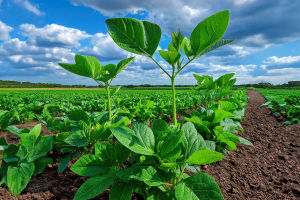We often admire the beauty of a plant's leaves, flowers, or fruits, but have you ever thought about what's going on beneath the soil? Roots are the unsung heroes of plant life, working quietly to supply the plant with the essential water and nutrients it needs to survive.
In this article, we'll explore how plants use their root systems to gather these resources and how different root types play specific roles in a plant's health and growth.
The Function of Roots
Roots serve several critical functions for plants. The most important function is to anchor the plant to the ground, preventing it from being uprooted by wind or rain. But roots do much more than that—they absorb water and nutrients from the soil, store energy in the form of starch, and even facilitate communication between different parts of the plant.
The process of absorbing water and nutrients begins when the roots grow into the soil, seeking moisture and minerals. Specialized root cells called root hairs increase the surface area of the root, allowing it to absorb more water and nutrients. These nutrients include essential elements like nitrogen, phosphorus, and potassium, which are vital for the plant's growth and development.
Types of Root Systems
There are different types of root systems, each adapted to the plant's environment and needs. Let's take a closer look at the most common root types:
Taproot System
Many plants, such as carrots and dandelions, have a taproot system. In this system, the main root grows deep into the soil, allowing the plant to access water and nutrients from deeper layers of soil. The taproot acts as an anchor, providing stability to the plant. It also stores food and nutrients that can be used by the plant later on.
Fibrous Root System
On the other hand, plants like grasses have a fibrous root system. Instead of a single deep root, the plant grows a network of smaller, thinner roots. This system is more efficient for absorbing water and nutrients from the surface layers of soil, especially in areas with heavy rainfall. The fibrous roots spread out in all directions, creating a dense mat that helps prevent soil erosion.
Adventitious Roots
Some plants, like ivy or mangroves, grow adventitious roots, which emerge from stems or leaves, rather than from the base of the plant. These roots help the plant stay anchored to surfaces or even help the plant grow in unusual environments. For example, mangroves grow adventitious roots in coastal areas, allowing them to thrive in saltwater habitats.
How Roots Absorb Water and Nutrients
The absorption of water and nutrients by roots is a complex process. Roots rely on a combination of physical and chemical mechanisms to draw water and nutrients from the soil:
1. Osmosis: Water moves from areas of low concentration of solutes (like minerals) to areas of high concentration inside the root cells. This movement helps the plant maintain hydration and supports its internal processes.
2. Active Transport: While water moves passively, some nutrients require energy to be absorbed into the plant. This process is known as active transport, where the plant uses energy to move essential minerals like potassium, calcium, and magnesium into the root cells.
3. Capillary Action: This is the process by which water moves upward from the roots through the plant's vascular system. Capillary action allows water to travel against gravity, reaching the leaves and stems where it's used for photosynthesis.
Root Adaptations for Different Environments
Roots are incredibly adaptable and can evolve to suit specific environmental conditions. For example:
• Desert Plants: In dry environments, some plants have long, deep taproots that can access water stored deep underground. Other desert plants have shallow, wide-spread root systems to capture water from infrequent rainfall quickly.
• Flooded Areas: In areas with poor drainage or frequent flooding, plants like rice have specialized root structures called aerenchyma, which allow oxygen to reach the roots even when the soil is waterlogged.
• Tropical Rainforests: In humid, tropical climates, plants often develop shallow root systems that spread horizontally, taking advantage of the nutrient-rich topsoil.
The Importance of Healthy Roots
Healthy roots are essential for healthy plants. Without proper root function, a plant cannot absorb the nutrients and water it needs to grow and thrive. A lack of water or vital minerals can lead to poor growth, wilting, or even death. Roots are also vulnerable to diseases like root rot, caused by overwatering or fungal infections, which can severely impact a plant's health.
We should take care to ensure our plants have good soil, proper watering practices, and healthy root environments. For gardeners, understanding the role of roots and the different root systems helps in choosing the right plants for specific environments and improving plant care.
Conclusion: The Hidden Power Beneath the Soil
In conclusion, while the leaves and flowers of plants often steal the spotlight, the roots are the true lifeline. These underground structures are constantly at work, gathering water and nutrients, and ensuring the plant's survival. With different root systems suited to various environments, plants have evolved remarkable strategies to thrive in diverse conditions.
So, next time you admire a plant, remember the incredible role its roots play in sustaining its life. Whether deep beneath the soil or spreading wide to cover the surface, roots are the foundation of every plant's success.


